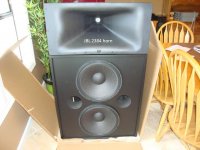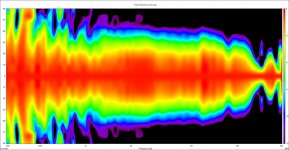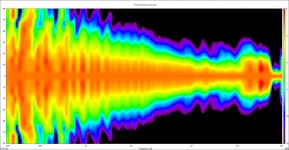I also use the 18Sound ND1460 (not -A. I use the titanium version - better for PA use), and that gets another thumbs-up. Titanium diaphragms are incredibly tolerant to abuse - you'll hear the diaphragm hit the phase plug in response to LF and little (if any) damage will occur. Aluminium diaphragms aren't so tolerant.
Chris
Actually the material characteristics of Titanium and Aluminium are very similar. (..depending on the "grade" of each.)
The "A" versions have less non-linear distortion lower in freq. due, (not to the diaphragm itself), to the suspension. In the Titanium version it's a "one-piece" construction with the surround being Titanium (as part of the diaphragm), this accelerates fatigue of the diaphragm and particularly the surround. The Aluminium version has a more forgiving and damped poly surround.
I think it would be interesting to see one with a Titanium "one-piece" in a beta-phase (..that should be very durable to bending).
Last edited:
Hi Scott,
I more meant that an aluminium diaphragm won't hold up so well to abuse, like accidentally missing out a crossover and hitting the compression driver with a few hundred watts of dubstep-style bass. Happened to mine at an amplifier demo. Inspection afterwards revealed everything was fine.
I'd be very very surprised if an aluminium diaphragm would survive that sort of thing.
Aluminium tends to be softer than titanium, so the 10kHz+ break-up will be a bit more benign.
Chris
I more meant that an aluminium diaphragm won't hold up so well to abuse, like accidentally missing out a crossover and hitting the compression driver with a few hundred watts of dubstep-style bass. Happened to mine at an amplifier demo. Inspection afterwards revealed everything was fine.
I'd be very very surprised if an aluminium diaphragm would survive that sort of thing.
Aluminium tends to be softer than titanium, so the 10kHz+ break-up will be a bit more benign.
Chris
See Heritage Klipsch - that big "theater" sound and "HOM" ? - Technical/Modifications - The Klipsch Audio Community
If you're wanting a cheap approximation of the K-510 to try out (with suitable EQ applied to tame the 1-4 kHz hump in response, and a little HF boosting ramp filter on the 5-16+ kHz...just like the K-510 horn needs), here is a very good horn that's also very inexpensive and that tests very well in terms of its polars relative to the K-510:
2" Throat Horn Bolt-On 18"x10"For Assorted Bolt On 2"Exit Drivers 90degx 40deg(398) | eBay
First horizontal:

Then vertical:
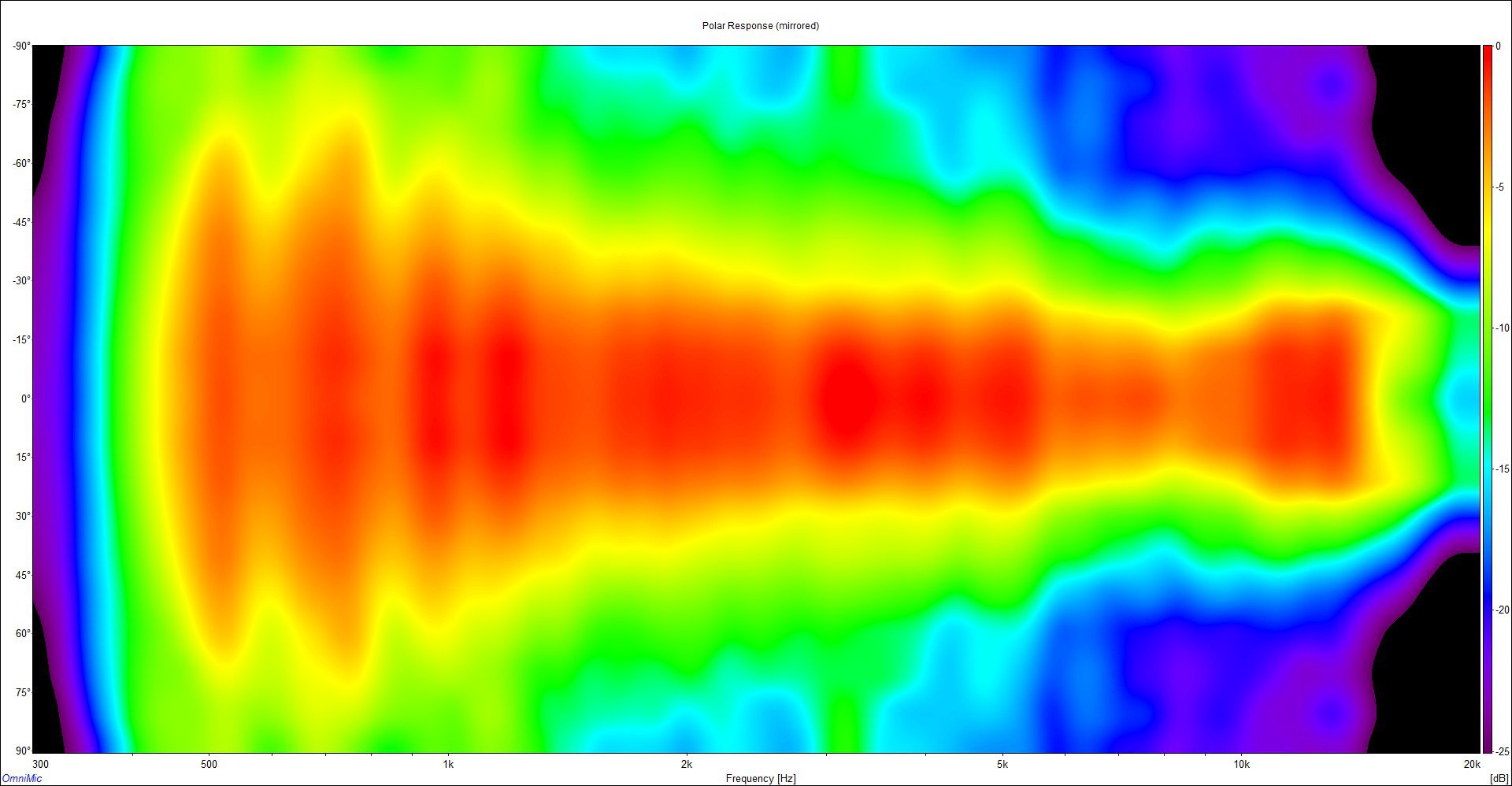
The polars of the BMS 4592ND will be the even better up high (10-20 kHz) due to the absence of diaphragm breakup that the Klipsch K-69-A exhibits in the plots linked just above.
The K-402 used with a BMS 4592ND is superb. Here is an on-axis SPL/phase plot of the MEH version of that horn with dual 15" Crites cast frame woofers. Pay particular attention to the difference between the minimum phase trace and the total phase trace. (A hint: it's the best I've seen in a full-range horn.)
frequencyresponseandphasewithminphase.jpg.62d5d8add00e49ed06d45474dc2fcd86.jpg)
Chris
Actually your projects with the k-402 waveguide were part of the inspiration for this when I saw the great results and wide frequency range you were covering. I have no idea where to source a k-402 waveguide though as apparently klipsch will only sell them with an expensive driver attached?
Do you have a normalised version of those polar plots? (IE what they would look like with flat on axis frequency response)
Test Bench: RCF ND950 Neodymium Compression Driver and HF950 Horn | audioXpress
Driver:
-I'd look to the 18 Sound 1460A or 1480A. Better linearity AND a much easier Impedance to work with..
Here is the 1460A on an 18 Sound XT1464:
The Raptor ... a 10" MTM
Thanks for the info these drivers do look better than the RCF ones and look to work well down to 800 Hz.
I'm working with Don Keele and Bjorn Kolbrek on a horn design that have several of the same specifications. A 2-way design that requires a separate bass/subwoofer solution. May also get a horn subwoofer designed with it.
- 80x50 coverage angle
- Frequency range 90 Hz-18KHz or higher
- Crossover at 600 Hz or lower if the driver permits it
- Very uniform directivity low in frequency
- Exit angle of 1.4" (Radian 951BePB driver) but could also be made for other drivers including those with an 1.5" exit
- Non resonant enclosure
Downside is the size the horn requires for constant directivty low in frequency and it's not cheap to build either. I have a Klipsch K-402 horn which I will use for comparison to the top horn. The top horn needs to be better than Klipsch for it to be worth it.
Already have measured and tested the midbass horn. While we'll may be making some adjustments to it, it does work tremendously well today. The horizontal directivty doesn't change much before you get to 100-150 Hz. Picture of it below with the Klipsch K-402 horn on top.
wow what a great looking project, kind of an all horn speaker done right. Do you have any idea where to get a pair of K-402?
The Radian 951BePB driver looks fantastic but like all Be drivers is a bit out of budget
The RCF HF94 gets a thumbs-up from me. I use it in my main PA system, and it does the job well. The HF950 appears to have a slight "pinch" before the final expansion, which isn't great for HOMs. It does load to a lower frequency, though.
I also use the 18Sound ND1460 (not -A. I use the titanium version - better for PA use), and that gets another thumbs-up. Titanium diaphragms are incredibly tolerant to abuse - you'll hear the diaphragm hit the phase plug in response to LF and little (if any) damage will occur. Aluminium diaphragms aren't so tolerant.
The thing to remember here is that larger exit diameters will beam at a lower frequency. A 1" exit driver will have reasonably good off-axis response past 10kHz, while a 2" exit driver will not. A 1.4" exit diameter is a decent compromise for a lot of applications.
Rod Elliott has a bit here: PA Systems
About compression driver exit diameters vs output vs LF cutoff.
The BMS coaxial compression drivers are really nice, but still constrained by the off-axis response of the exit diameter. ie, they might well get past 20kHz, but it could still be a laserbeam up there. Horns will constrain wavelengths that are trying to be omnidirectional, but when the compression driver itself is beaming, the horn becomes irrelevant.
My main PA system* will do what you're after with a bit of headroom, and sound good doing it. I wouldn't want to be in any domestic-sized space while it's run up to full power, though. Hopefully you're not planning on doing that.
*HF - 18Sound ND1460 on RCF HF94 horns
MF - 2x Faital Pro 10FH520
LF - Up to 4x Faital Pro 15HP1060
^ per side. You'd probably manage your SPL goals with 2x 15"s per side.
It'd be around 100 miles round-trip for you, but I'd be happy to demo that setup.
I've crossed over as low as 750Hz for PA use, which gives a really smooth off-axis response that matches to the 10"s well, but I usually run at about 1kHz out of concern for the HF driver's long-term health. No point in working them harder than necessary if the next band down can cover that range easily.
I also have a pair of 6.5" 2-way boxes that have 1" exit drivers. They'd probably manage 125dB peaks between them, but it'd be a couple of cycles "burst", while the 2x10"s can do >125dB sine waves.
If it's of interest, I wrote an article about SPL ratings in the PA world. It ain't pretty.
Spec Wars: Looking Inside Loudspeaker SPL Specifications - ProSoundWeb
Chris
Very interesting my sub bass setup is 4*200L boxes of dual opposed 15" drivers totalling 8 drivers. They are not super high performance drivers with only 8mm xmax but they were very cheap and seem to be well built, I have verified that they all reach decent levels of excursion in free air. ( Subwoofer Pyle PLPW15D specifications. ). If they don't work out I will just replace them with better drivers as funds permit, i'm a bit depth restricted on my cabinets for deep "uber" drivers. I would like to do power compression testing on the first sub I have built to see what they can do but don't have access to a space at the moment where I can reach anywhere near full output of just one sub.
I'd love to have a demo of your system, it looks to have a very similar design idea to what I have been aiming for with avoiding clusters and trying to get the whole thing as point source as possible. I'm actually in Sheffield on Friday this week in the evening so I could turn up earlier on Friday (3pm - 7pm period) if your available then.
Interesting article on the specs. I was aiming for 125dB because my friends Makie Thump 12 are rated as "125dB" Max SPL and defiantly go much louder than required at mid/high frequencies for the type of environments we are using them. I wonder how inflated their specs are? I already took a long look at their data sheet and found their bass response specs although correct quite misleading.
NOTE: Uses JBL CD standard of 1.5"
JBL 365359 001 Top WaveGuide for 3732 | $130 - $140
The USA Speaker Exchange ships internationally. The Speaker Exchange - Speaker repair, replacement, recone, refoam, parts and diy kits.
Thanks lots of hard to find things here!
Is your listening room a typical home living room 5 Meters by 5-10 meters? IF so you may not need constant directivity below 700hz where the XT1464 will match well to a 15 and deliver awesome results.
Another used option would be a JBL PD 5322 or another JBL compression driver cone mid combination. That's a hard to beat combo to 300hz.
Otherwise the SEOS 24 with BMS should be studied.
I'm not aiming to cross to a direct radiator, I have had an idea that I need to test out before I make a fool of myself before trying it out
Klipsch only sells the horn with driver attached--which deliberately raises the price. Their explanation is that they're not a parts house. There may be an MEH version of the horn in the near future.
Here are the normalized plots of the ZXPC horn. First horizontal:

then vertical:
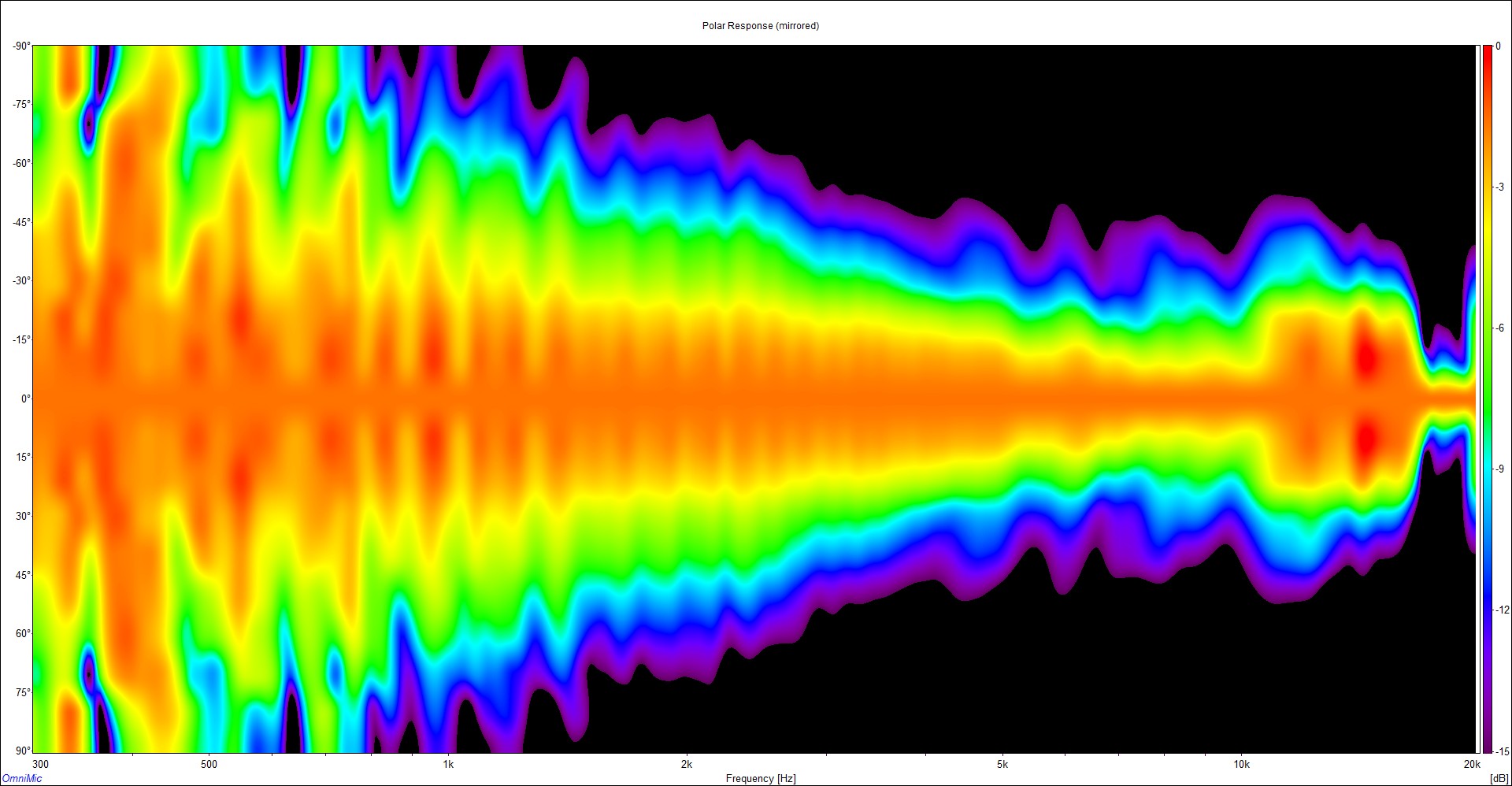
Here are the normalized plots of the ZXPC horn. First horizontal:
then vertical:
Attachments
The comment above about not needing directivity below 700 Hz--I find definitely not to be true. I can clearly hear the directivity effects down to below 100 Hz with the K-402-MEH vs. the K-510-sized horn which loses horizontal directivity at about 500 Hz. There is a distinct increase in clarity and much more neutral timbre with below-100 Hz directivity. It's not close. That's why I'm building 4 more K-402-MEHs.
I think a lot of people claim that there is little difference having directivity below ~500-700 Hz--because they've not heard good/consistent directivity below the claimed 700 Hz point, which is where most average size horns lose their horizontal directivity control.
Chris
I think a lot of people claim that there is little difference having directivity below ~500-700 Hz--because they've not heard good/consistent directivity below the claimed 700 Hz point, which is where most average size horns lose their horizontal directivity control.
Chris
I purchased mine K-402 from here:wow what a great looking project, kind of an all horn speaker done right. Do you have any idea where to get a pair of K-402?
The Radian 951BePB driver looks fantastic but like all Be drivers is a bit out of budget
American Cinema Equipment
It's only sold with drivers.
The less expensive Radian 951PB will also work great with an active system where EQ can be applied. So will several other drivers.
Totally agree with Cask05. Constant directivity lower than 700 Hz is very important. You need a big horn for that.
I purchased mine K-402 from here:
American Cinema Equipment
It's only sold with drivers.
The less expensive Radian 951PB will also work great with an active system where EQ can be applied. So will several other drivers.
Totally agree with Cask05. Constant directivity lower than 700 Hz is very important. You need a big horn for that.
Hi Omholt,
Can I ask: What was the price for a pair of K-402 horns?
Thanks!
Best regards
Peter
Klipsch only sells the horn with driver attached--which deliberately raises the price. Their explanation is that they're not a parts house. There may be an MEH version of the horn in the near future.
Here are the normalized plots of the ZXPC horn. First horizontal:
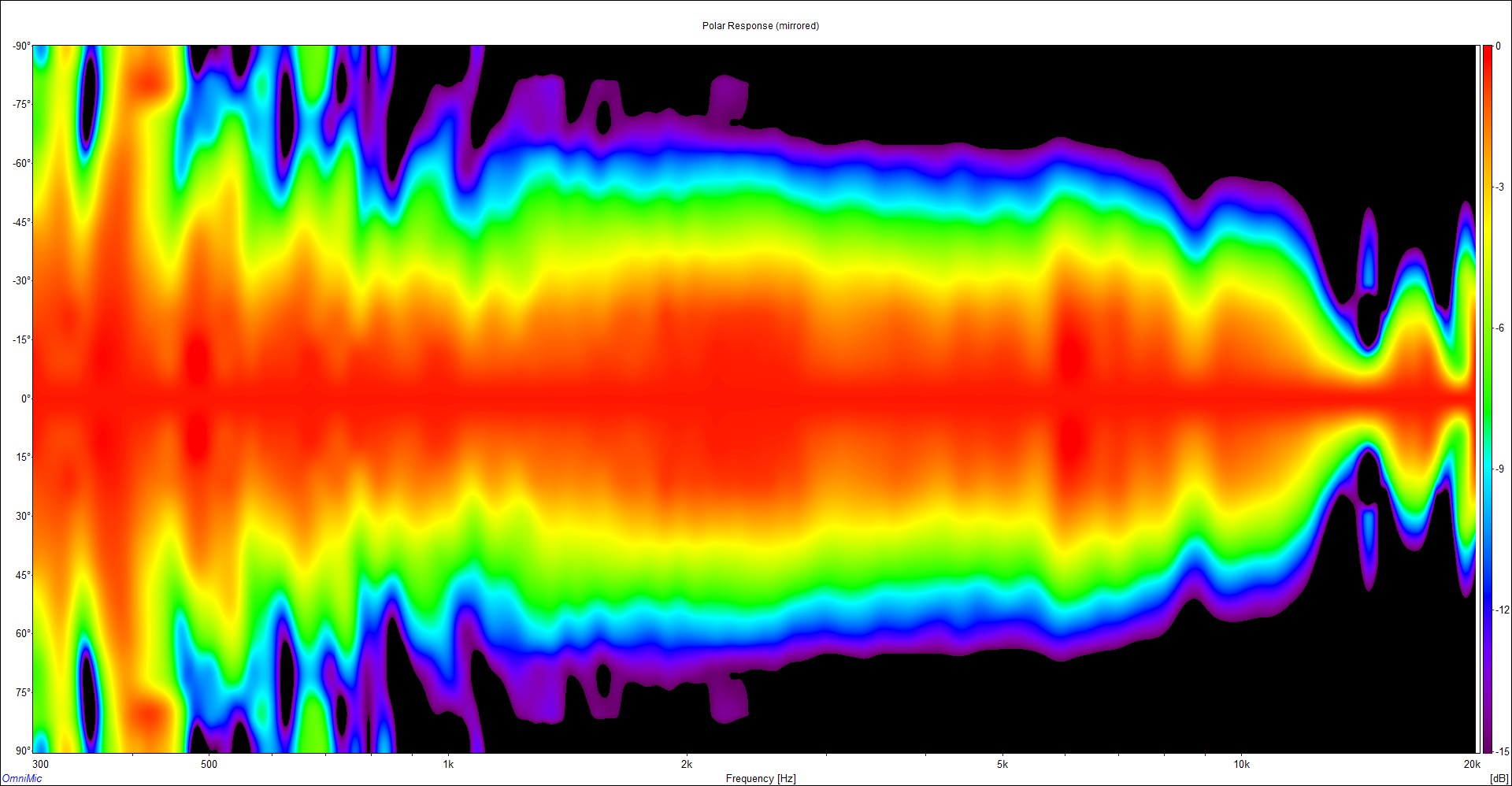
then vertical:
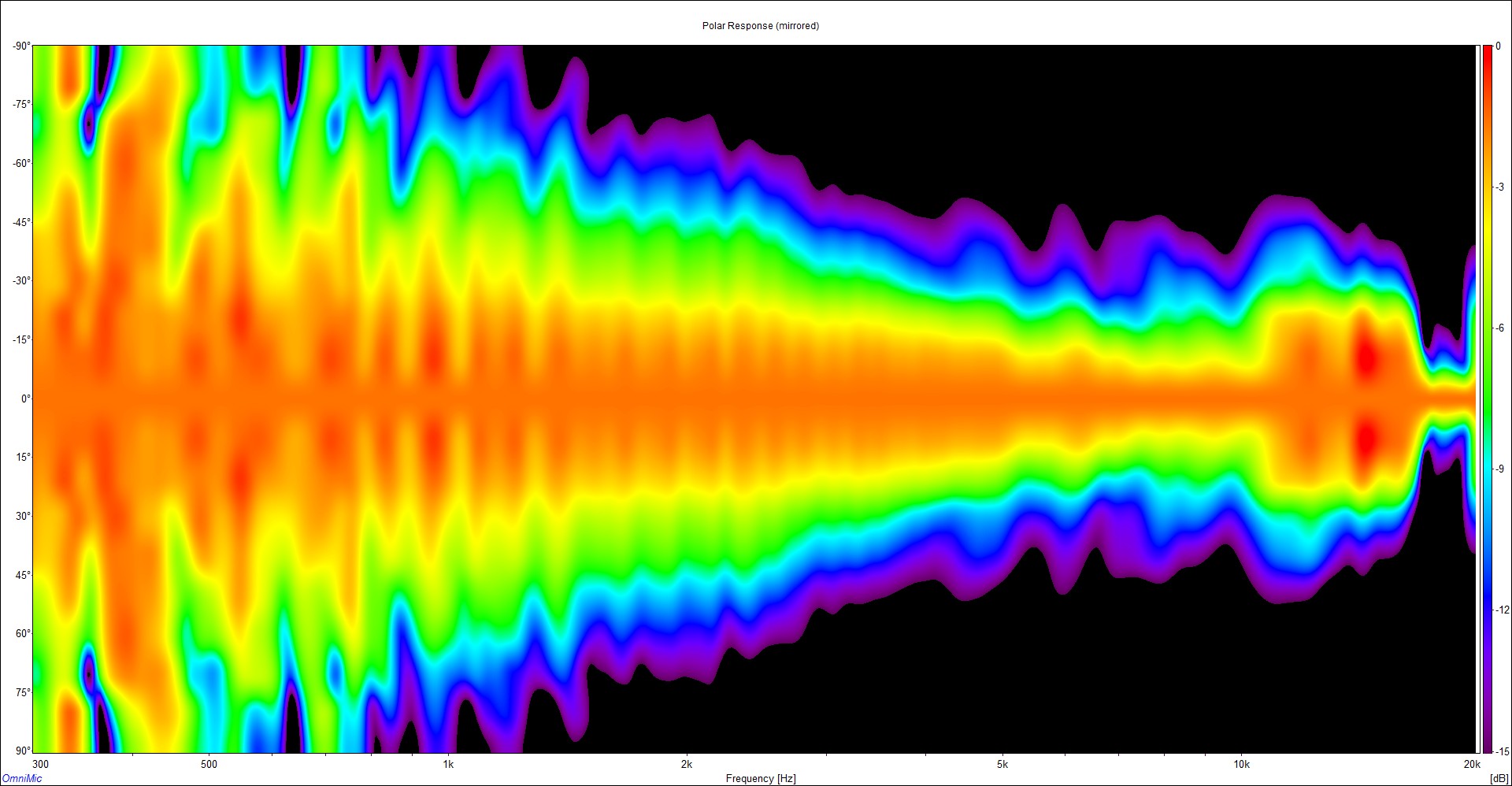
Thanks, I have ordered a couple of these horns as they are big, low ISH cost and the results look decent.
I will measure a few different drivers on them and posibly 3d print adaptors for smaller exit drivers.
I will probably also order the rcf flare for comparison. I get the feeling that in the UK it's good to get hold of these things when you can.
I paid $1942 including shipping to New Jersey where I forwarded it with Jetcarrier.Hi Omholt,
Can I ask: What was the price for a pair of K-402 horns?
Thanks!
Best regards
Peter
Can't remember the price without shipping. Best to contact cinequip for updated prices.
One should specify this when ordering: KPT-402-HF w/K69 driver that’s part of the 2-way Jubilee setup.
I paid $1942 including shipping to New Jersey where I forwarded it with Jetcarrier.
Can't remember the price without shipping. Best to contact cinequip for updated prices.
One should specify this when ordering: KPT-402-HF w/K69 driver that’s part of the 2-way Jubilee setup.
Thanks a lot!
Best regards
Peter
Again, you fail to state what you're actually saying, and I again see that there is no data to back up what you're implying.Is it possible you are benefiting from the clean response that the directivity brings but that there are other ways it can be done?
I believe that when you place a loudspeaker in a listening room and take measurements, you'll see that there is no substitute for true directivity--as only horns can produce. Arrays used for directivity control always depend on diffraction, and always exhibit off-axis power anomalies (called "side lobes") that make the compromise much less attractive.
I believe that Danley Sound Labs aptly discuss this subject: http://www.danleysoundlabs.com/wp-content/uploads/2012/01/line-array-paper.pdf
Chris
I'm ok with the idea. It's just that this isn't the way it went down. The 700Hz point we all mention was from a study regarding perception.
I think a lot of people claim that there is little difference having directivity below ~500-700 Hz--because they've not heard good/consistent directivity below the claimed 700 Hz point, which is where most average size horns lose their horizontal directivity control.
There are a lot of studies on psychoacoustics on the web--I believe is the point that I meant to make. Having some pointer to the one that you refer to is a big help. I'm reporting on the actual (subjective) listening differences of having good directivity control to much lower frequencies*, as well as making connections to the published literature where I can make connections.
I've seen the need for better horns (call them waveguides if you must) for some time--i.e., the type of configurations that the DIY community is drifting toward. I've been working on providing alternatives that are even more fit for purpose than the generally available ones and are much less expensive than $2K each (i.e., for the full-range horn), etc.
But the task is not simple, and I also do not wish to bite the hands that have fed me thus far (mainly Klipsch/Delgado). But I believe like Danley that the DIY community should be supported and encouraged. I continue to work the horn issue to meet DIY needs.
The K-510 and K-402 are big improvements when considering the factors that are generally shown to be most important:
* There are examples of loudspeakers having reasonably good directivity control to much lower frequencies without using arrays of drivers or large planar configurations (with their inherent limitations). I can immediately think of the Klipschorn that has withstood the test of time, but also the La Scala, Belle, and Jubilee in more recent years. The JBLs all have some form of direct radiating bass except perhaps the 1950s-era Paragon series and Hartsfield models (which are much too rare and now too expensive due to collectors). The Danley MEH models (Sound Physics Labs TD series, Danley Sound Labs Synergy series) now have taken center stage in terms of directivity control to lower frequencies. The problem is: they all are moderately rare to most DIYers nowadays, so many people haven't heard the difference between direct radiating bass and well-designed horn-loaded bass.
I've seen the need for better horns (call them waveguides if you must) for some time--i.e., the type of configurations that the DIY community is drifting toward. I've been working on providing alternatives that are even more fit for purpose than the generally available ones and are much less expensive than $2K each (i.e., for the full-range horn), etc.
But the task is not simple, and I also do not wish to bite the hands that have fed me thus far (mainly Klipsch/Delgado). But I believe like Danley that the DIY community should be supported and encouraged. I continue to work the horn issue to meet DIY needs.
The K-510 and K-402 are big improvements when considering the factors that are generally shown to be most important:
- excellent polar response,
- low HOM generation/absence of long diffraction slots in the throat of the horn, neutral sounding
- extremely wide directivity controlled pass band for MEH use and geometry that supports mounting of off-axis drivers, if desired
- reasonable cost, and
- perhaps a better visual appearance than molded ABS black mat finish
* There are examples of loudspeakers having reasonably good directivity control to much lower frequencies without using arrays of drivers or large planar configurations (with their inherent limitations). I can immediately think of the Klipschorn that has withstood the test of time, but also the La Scala, Belle, and Jubilee in more recent years. The JBLs all have some form of direct radiating bass except perhaps the 1950s-era Paragon series and Hartsfield models (which are much too rare and now too expensive due to collectors). The Danley MEH models (Sound Physics Labs TD series, Danley Sound Labs Synergy series) now have taken center stage in terms of directivity control to lower frequencies. The problem is: they all are moderately rare to most DIYers nowadays, so many people haven't heard the difference between direct radiating bass and well-designed horn-loaded bass.
- Home
- Loudspeakers
- Multi-Way
- 1.4" or 2" throat large constant directivity horns you can actually buy!
